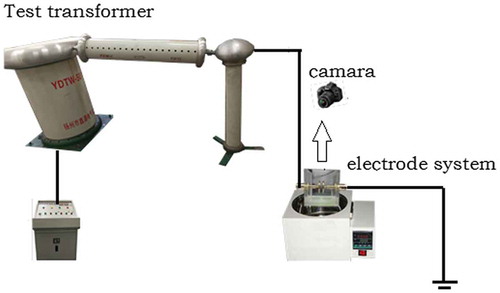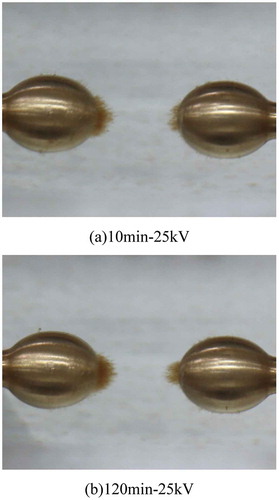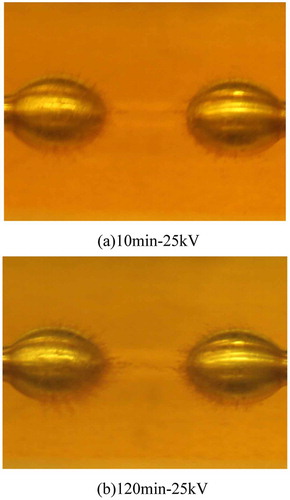Abstract
Natural esters usually show higher dielectric losses, a higher conductivity and higher viscosity. It has become clear that more research is required to ascertain the long-term safe operation of transformers where natural ester is used. This paper made comparative experimental analysis of the cellulosic particles accumulation and its effect on the electric field distribution in natural ester and mineral oil under AC electric field. When the AC voltage was applied on the oil with cellulose particles, it is worth noting that in mineral oil, the particles were concentrated at the end of the spherical positive and negative electrodes, while in the natural ester, the particles are concentrated in the sphere of the positive and negative electrodes. The adsorption of fiber particles decreases the field intensity near the spherical electrode, however, increases the field strength in the middle region of the electrode. Besides, in the case of particles adsorbed on the electrode surface, the maximum electric field strength appears at the particle edge in mineral oil is a little higher than the value in natural ester.
1. Introduction
Power transformers usually contain numerous tons or over a hundred tons of insulating oil. The insulating oil inside a transformer normally contacts metal, iron core and pressboard insulation. Metal filings or cellulosic residual can be formed in the oil [Citation1–Citation4]. There is cellulose shedding phenomenon for transformer in operation, especially for aged transformers with old oil-paper insulation [Citation1–Citation4]. The level of oil contamination determines the dielectric safety margin of both new and aged oil-paper insulation system [Citation1–Citation4].
The most commonly used liquid in transformers is mineral oil because of its low cost and good properties. However, the performance of mineral oil starts to be limited with the environmental consideration. Natural ester takes advantages over mineral oil in the aspects of fire safety, environment, and insulation aging, and is found to be suitable for the use in transformer insulation system [Citation5–Citation7]. In recent years, some researchers [Citation1–Citation4] studied the bridging phenomena in mineral oil contaminated with cellulose particles. However, the bridging forming model and the motion property of cellulose particles in natural ester has not been studied sufficiently [Citation3]. Investigating cellulosic particles accumulation and its effect on the electric field distribution characteristics of natural ester is not only useful to further understand the insulation failure and ensure the safe operation of the transformer, but also helpful to guide the transformer insulation structure design, especially for the transformer which would use natural ester in the future.
In the present study, cellulosic particles accumulation phenomenon and its effect on the electric field distribution in natural ester and mineral oil under AC electric field were compared.
2. Experiments
The main parameters of the mineral oil and natural ester used in this experiment were shown in . The test cell used in all experiments was cube glass cup whose volume is 1100 ml. A pair of spherical electrodes with a diameter of 13 mm have been used for the experiments. Their distance was 10 mm and material was copper. Two electrodes are symmetrically positioned on both sides of the test cell. A block diagram of complete experimental setup is shown in . The AC voltage was provided by a 50 kV AC Test Transformer Model YDTW-50/100. One of sphere electrodes was attached to the AC high voltage source. The other electrode was connected to the ground. A digital Cannon camera was used to record the optical images of the particles accumulation. The AC voltage (RMS 25 kV) was applied when the electrode distance is 10 mm in order to observe the bridging behaviour in mineral oil and natural ester.
Table 1. Parameters of mineral oil and natural ester.
3. Results and discussions
3.1. Cellulose particles motion characteristics
When the AC voltage (RMS 25 kV) is applied, cellulose particles in mineral oil and natural ester was observed to accumulate gradually to the positive and negative electrodes, as shown in Figures and . The longer the AC voltage applied, the greater the amount of particles accumulated on the surface of positive and negative electrodes. It is worth noting that, in mineral oil, the particles were concentrated at the end of the spherical positive and negative electrodes, while in the natural ester, the particles are concentrated in the sphere of the positive and negative electrodes. In the mineral oil, the particles accumulated were compact, while in the natural ester, the particles accumulated were sparse. In mineral oil, the particles adsorbed on the electrode presents a spherical cap. In natural ester (), the cellulose particles absorbed on the spherical electrode arranged radially (). This phenomenon may be related to the conductivity of the oil and the particles.
3.2. Cellulose particles accumulation effect on the electrical field distribution
The electric field distribution results calculated using COMSOL software under the simulation condition in this paper are shown in Figures and . The simulation parameters are shown in . It could be seen that the cellulose particles adsorbed by the positive and negative electrode under AC electric field has significant influence on the electric field distribution. The electric field distribution from the top of the left spherical electrode to the top of the right spherical electrode in clean mineral oil, mineral oil contaminated with cellulose particles, clean natural ester and natural ester contaminated with cellulose particles is shown in .
Figure 4. Electrical field distribution in mineral oil and mineral oil contaminated by cellulose particles (a) mineral oil-35.35 kV (b) mineral oil-cellulose particles-35.35kV.
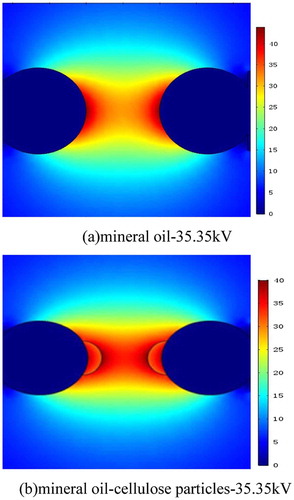
Figure 5. The electrical field distribution in natural ester and natural ester contaminated by cellulose particles under AC peak value (a) natural ester-35.35 kV (b) natural ester-cellulose particles-35.35kV.
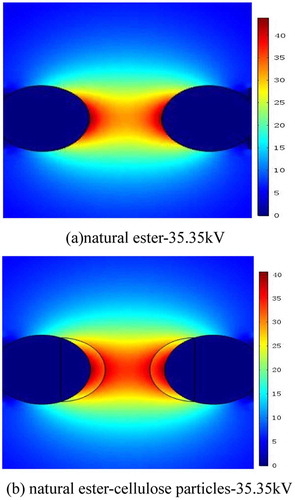
Figure 6. The electric field distribution from the top of the left spherical electrode to the top of the right spherical electrode.
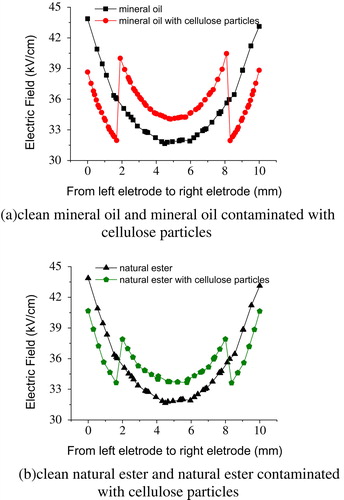
Figure 7. Electric field distribution from the top of the spherical electrode to the bottom of the electrode.
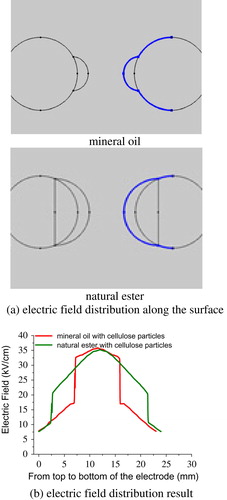
In mineral oil without cellulose particles, the maximum field strength appears at the top area of the spherical electrode ((a), (a)). While for the mineral oil contaminated with cellulose particles, due to the adsorption of fibre particles on spherical electrode tip, the higher field strength appears at the top area of the spherical electrode and the top of the ball shaped fibre particles ((b), (a)). The electrical field strength at the top of the ball shaped fibre particles is maximum. In clean natural ester, the maximum field strength also appears at the top area of the spherical electrode ((a), (b)). However, in natural ester contaminated with cellulose particles, the higher field strength appears at the top area of the spherical electrode and the outer edge of the radial fibrous layer ((b), (b)).
The maximum field strength appears at the top area of the spherical electrode. The adsorption of fibre particles decreases the field intensity near the spherical electrode, however, increases the field strength in the middle region of the electrode. Besides, in the case of particles adsorbed on the electrode surface, the maximum electric field strength appears at the particle edge in mineral oil is a little higher than the value in natural ester (Figure7).
4. Conclusion
Under AC electric field, in mineral oil, the particles were concentrated at the end of the spherical positive and negative electrodes, while in the natural ester, the particles are concentrated in the sphere of the positive and negative electrodes. The cellulose particles adsorbed by the electrode has significant influence on the electric field distribution. The field intensity near the spherical electrode was reduced, however, the field strength in the middle region of the electrode was increased. In the case of particles adsorbed on the electrode surface, the maximum electric field strength appears at the particle edge in mineral oil is a little higher than the value in natural ester.
Disclosure statement
No potential conflict of interest was reported by the authors.
Funding
This work was supported by the Science and Technology Project of the State Grid Corporation of China (Research on key technology for mixed insulation oil transformer).
Notes on contributors
 Jian Hao
received the Doctor degree (2012) from the College of Electrical Engineering in Chongqing University, China. Now his research activities are mainly in the field of oil-paper insulation ageing mechanism, dielectric response and space charge characteristics of the transformers.
Jian Hao
received the Doctor degree (2012) from the College of Electrical Engineering in Chongqing University, China. Now his research activities are mainly in the field of oil-paper insulation ageing mechanism, dielectric response and space charge characteristics of the transformers.
 Qian Wang
received the master degree of Electrical Engineering from Chongqing University in 2005. He is currently a senior engineer of the State Grid Chongqing Electric Power Co. Chongqing Research Institute. His main research field is online monitoring of the high voltage equipment.
Qian Wang
received the master degree of Electrical Engineering from Chongqing University in 2005. He is currently a senior engineer of the State Grid Chongqing Electric Power Co. Chongqing Research Institute. His main research field is online monitoring of the high voltage equipment.
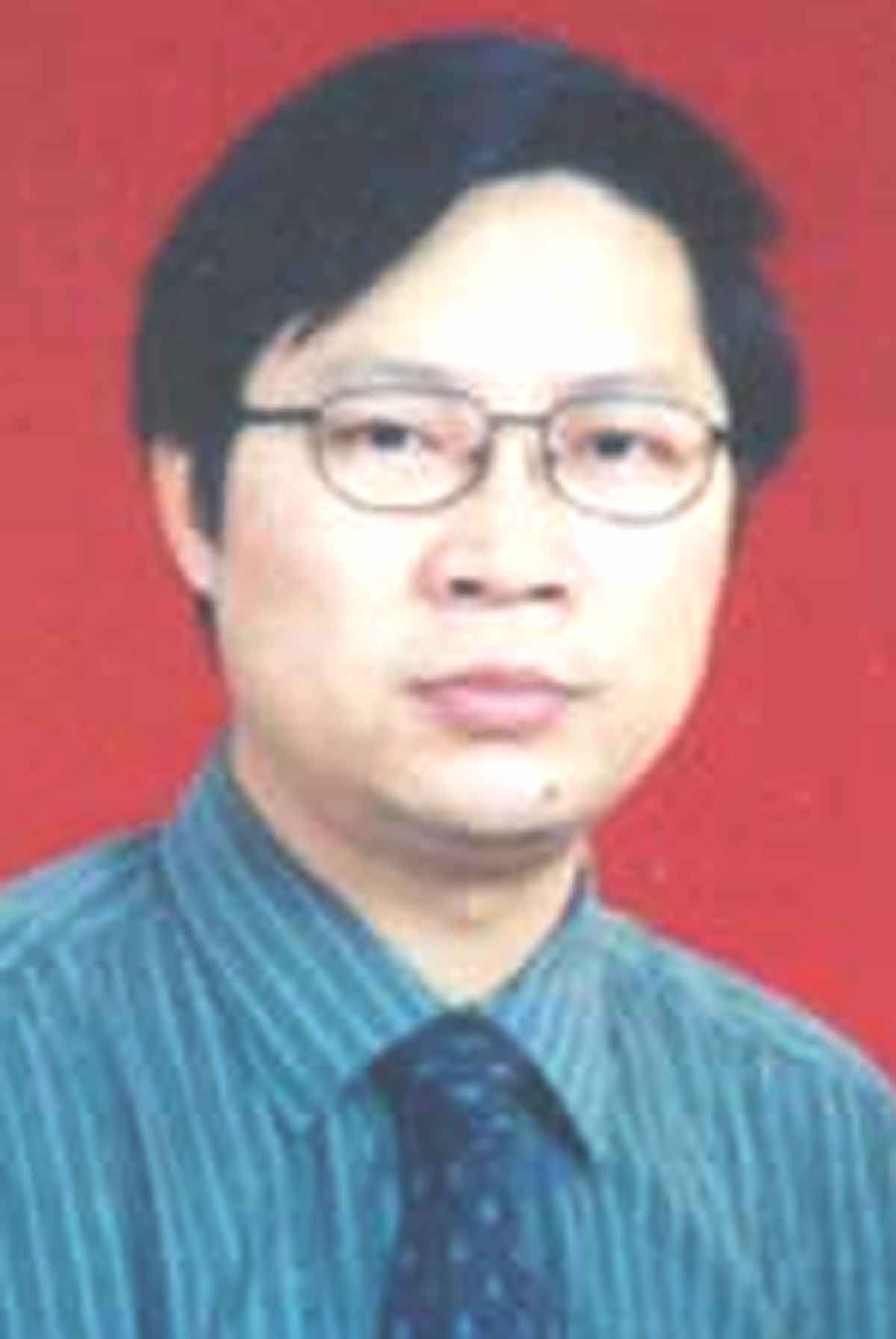 Ruijin Liao
received the MS and PhD degrees in electrical engineering from Xi’an Jiaotong University, China and Chongqing University, China, respectively. Since 1999 he is a professor of Electrical Engineering College at Chongqing University, China. His research activities lie in the field of online monitoring of insulation condition and fault diagnosis for high voltage apparatus, as well as ageing mechanism and diagnosis for power transformer. He is author/ coauthor of one book and over 90 journal and international conferences.
Ruijin Liao
received the MS and PhD degrees in electrical engineering from Xi’an Jiaotong University, China and Chongqing University, China, respectively. Since 1999 he is a professor of Electrical Engineering College at Chongqing University, China. His research activities lie in the field of online monitoring of insulation condition and fault diagnosis for high voltage apparatus, as well as ageing mechanism and diagnosis for power transformer. He is author/ coauthor of one book and over 90 journal and international conferences.
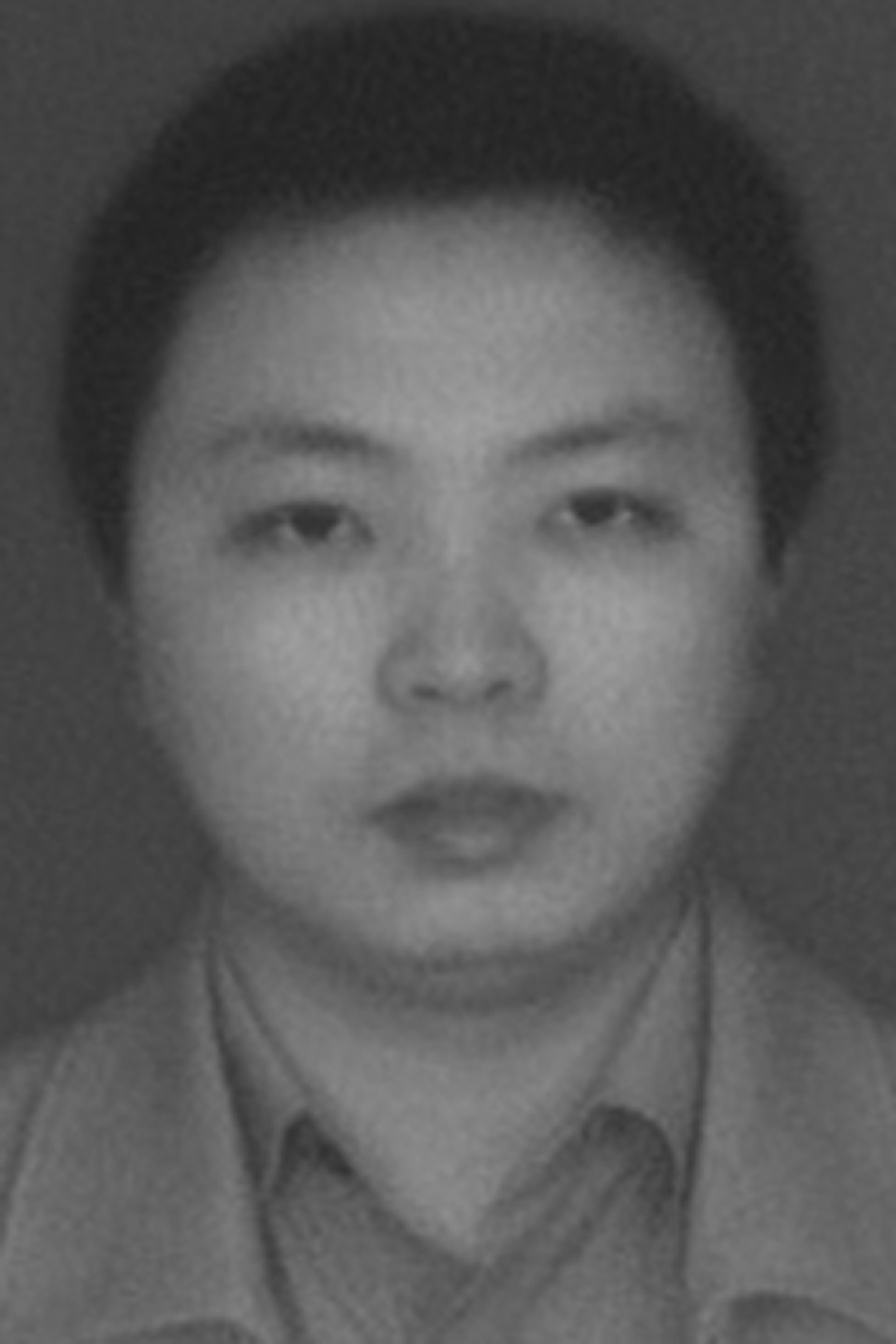 Gaolin Wu
received the master bachelor’s degree of Electrical Engineering from School of Water Resources and Hydropower Engineering in 2000. He is currently a senior engineer of the State Grid Chongqing Electric Power Co. Chongqing Research Institute. His main research field is online monitoring of the high voltage equipment.
Gaolin Wu
received the master bachelor’s degree of Electrical Engineering from School of Water Resources and Hydropower Engineering in 2000. He is currently a senior engineer of the State Grid Chongqing Electric Power Co. Chongqing Research Institute. His main research field is online monitoring of the high voltage equipment.
Acknowledgements
The authors thank the Science and Technology Project of the State Grid Corporation of China (Research on key technology for mixed insulation oil transformer).
References
- Mahmud S, Chen G, Golosnoy IO, et al. Bridging phenomenon in contaminated transformer oil. International Conference on Condition Monitoring and Diagnosis; 2012; Piscataway, US.
- Mahmud S, Chen G, Golosnoy IO, Wilson G, Jarman P. Experimental studies of influence of different electrodes on bridging in contaminated transformer oil. IEEE Trans Dielectr Electr Insul. 2015;22(5):2433–2441.10.1109/TDEI.2015.004846
- Zainuddin H, Zainoddin MHS, Aman A. Investigation of bridging phenomena in ester oils contaminated with cellulose particles. International Conference on Power, Energy, and Communication Systems (IPECS) Perlis; 2015 August; Malaysia.
- Martin D, Khan I, Dai J, et al. An overview of the suitability of vegetable oil dielectrics for use in large power transformers. Proceedings of the TJH2b Euro Tech Con; 2006; Chester, UK.
- Martin D, Wang ZD, Dyer P, et al. A comparative study of the dielectric strength of ester impregnated cellulose for use in large power transformers. 2007 International Conference on Solid Dielectrics; 2007; Winchester, UK.
- Hao Jian, Liao Ruijin, Ma Zhiqin, Yang Lijun. Influence of natural ester on frequency dielectric response of impregnated insulation pressboard. IET Sci Meas Technol. 2012;6(6):403–411.10.1049/iet-smt.2011.0180
- Ruijin Liao, Jian Hao, Chen George, Ma Zhinqin, Lijun Yang. A comparative study of physicochemical, AC breakdown and thermal stability of natural ester/pressboard insulation and mineral oil/pressboard insulation. IEEE Trans Dielectr Electr Insul. 2011;18(5):1626–1637.

